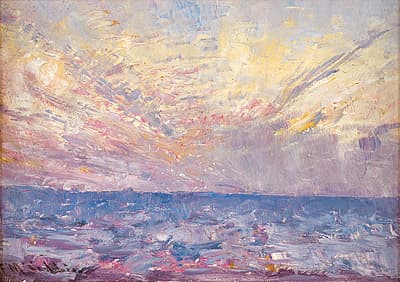Frederick
MCCUBBIN
Australia
1855
–
1917
Setting sun
c.1911
oil on wood panel
23.6 (h)
x 33.4 (w)
cm
Art Gallery of South Australia, Adelaide
M.J.M. Carter AO Collection 2006
Setting sun is a celebration of colour and light, and was probably painted at Williamstown. Completely devoid of any narrative, McCubbin’s primary interest was in the quality of the paint surface. This small study is rapidly painted with a multitude of varied brushstrokes which radiate in the sky to the far corners of the composition. There is a great sense of freedom of approach in the use of a divided palette of purple, blue, pink and yellow, producing brilliantly coloured sparkling effects.
McCubbin’s enthusiastic exploration of light in his late works is vividly articulated in Setting sun. McCubbin also noted the significance of light in his writings on Australian art:
As Monet says, ‘light is the chief sitter everywhere’. Yet it seems, that in no other country does the natural background present such a responsive medium as in Australia, pitched as our landscape is, in a somewhat minor key (‘Some remarks’, MacDonald 1916, p 84).
Nevertheless, Setting sun is filled with joy, showing an indulgent and experimental fascination with colour. On 27 January 1909, writing to Tom Roberts, McCubbin recalled: ‘You remember what Balzac says in that story The Unknown Masterpiece (If it’s colour it will break bounds)’ (Tom Roberts letters, ML).
When this work was exhibited in 1911, a reviewer described it as one of the prominent ‘charming studies direct from nature’ included in the show (Argus, 8 April 1911, p 21).
Rebecca Andrews
